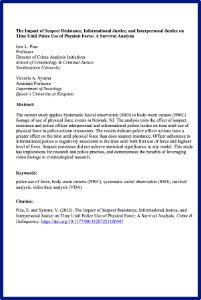By Geoffrey C. Barnes, Simon Williams | Lawrence W. Sherman | Jesse Parmar | Paul House | Stephen A. Brown
In this article, we examine how communities can maximize deterrence of crime while minimizing cost and police intrusion on public life. Using 3,720 hot spot-days, we show that the “sweet spot” duration of police absence, to maximize the residual deterrence of crime, was a full four days after the last day of targeting police patrol at each hot spot. Over a 248-day period, we randomly reshuffled 15 separate hot spots daily into either treatment (targeted police patrols) or control (no targeted patrols) for that day, so that all locations repeatedly switched between randomly assigned groups. This repeated crossover design (Cochrane & Cox, 1957; Fienberg et al., 1980) included random periods of up to 20 consecutive days in which individual hot spots remained in the control condition, allowing us to measure how soon, and by what trajectory, the residual deterrent effect of targeted patrolling wore off. After four days without patrolling, there was a sudden termination of residual deterrence, marked by a 66% rise in offense frequency, and a 395% spike in our index of crime harm (House & Neyroud 2018), compared to the treatment condition. It may be possible to deploy less, not more policing and still maximize deterrent effects.
Sweet Spots Pre-Print 2020-07





















